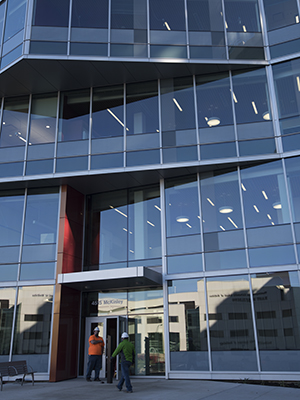New center focuses on regenerative medicine
The center aims to develop new treatments that could allow doctors to regrow or replace a damaged heart or severed nerves, or to restore lost vision or hearing

Leadership of the university’s Center of Regenerative Medicine, (from left) Angela Bowman, PhD, Shelly Sakiyama-Elbert, PhD, and Lilianna Solnica-Krezel, PhD, toured the 4515 McKinley Research Building during construction. <em>Photo: Robert Boston</em>
A new center has been formed at Washington University School of Medicine in St. Louis to facilitate research that explores the regenerative properties of cells and tissues. The goal of the Center of Regenerative Medicine is to develop new medical treatments that might one day allow doctors to regrow or replace a damaged heart or severed nerves, or restore lost vision or hearing.
The new center will foster research collaborations across the School of Medicine and Danforth campuses, providing more resources for investigators in diverse disciplines.
The new center is helmed by co-directors Lilianna Solnica-Krezel, PhD, the Alan A. and Edith L. Wolff Distinguished Professor and head of the Department of Developmental Biology; Shelly Sakiyama-Elbert, PhD, professor of biomedical engineering; and executive director Angela N. Bowman, PhD, assistant professor of developmental biology.
“We want to facilitate research in the area of regenerative medicine, eventually leading to new methods to promote tissue regeneration in ways that improve healing,” Solnica-Krezel said. “We have about 70 faculty involved in the center from across the entire School of Medicine, plus the Departments of Biology and of Biomedical and of Mechanical Engineering on the Danforth Campus.”
Along with other School of Medicine centers and divisions, the center is headquartered in the recently opened 4515 McKinley Research Building.

The center encourages collaborations in areas including tissue regeneration, stem cell research, cellular reprogramming, cell and tissue engineering, and across the spectrum of development from understanding the earliest stages of the embryo to the latest stages of the aging process. According to the center’s leadership, the areas of medicine and health with the potential to benefit from regenerative medical research are vast and diverse, from understanding the origin of birth defects to outlining the processes that govern degenerative diseases of aging, including heart disease and cancer.
“Regenerative medicine is not just about stem cells,” Solnica-Krezel said. “We have faculty who are interested in the field of cellular reprogramming, where a skin cell can be reprogrammed into a brain cell, for example, without going through a stem cell phase.”
“New methods to study regeneration are continually expanding and growing,” she added. “The goal of our center is to support our investigators who are exploring these methods to promote healing, and tissue repair and replacement, and to bring people studying these methodologies to Washington University.”
Bowman, whose research has focused on visual disorders and the regenerative properties of structures of the eye, noted that regenerative medicine is a popular topic of research. But despite the field’s progress, there remain numerous problems to be solved, from progressive blindness, to age-related hearing loss, to diabetes, to paralysis from spinal cord injuries.
Indeed, one example of the type of collaboration the center aims to foster is that between Sakiyama-Elbert’s lab in the Department of Biomedical Engineering and noted peripheral nerve surgeon Susan E. Mackinnon, MD, the Sydney M. Jr. and Robert H. Shoenberg Professor and chief of the Division of Plastic and Reconstructive Surgery.
MacKinnon has pioneered techniques for rewiring and transplanting peripheral nerves, those that govern function and feeling in the limbs. Sakiyama-Elbert’s lab has studied nerve regeneration in both the peripheral and central nervous systems. Together, they are investigating whether biomedical scaffolds, combined with cellular proteins called growth factors, can help guide damaged peripheral nerves as they regenerate. Such techniques might improve and speed the peripheral nerve healing process, and perhaps inform efforts to promote healing of nerves in the spinal cord, which do not regenerate on their own.
“We hope the center will help researchers in different fields come together and talk about innovative projects that wouldn’t happen otherwise,” Sakiyama-Elbert said.
In addition to a forum for collaboration, the center provides a number of resources for faculty. Solnica-Krezel led efforts to open the School of Medicine’s Zebrafish Facility, helping to establish zebrafish as an important model organism for studying vertebrate development and regeneration. Other resources include support in bioinformatics and statistics to help scientists design experiments, and store and analyze large amounts of data, such as that produced by genome sequencing. The center also supports core resource centers for support in handling stem cells and in developing mouse models of disease.
The center has several avenues for investigators to apply for funding, including seed grants and graduate fellowships in regenerative medicine provided by Philip and Sima Needleman, to further support research in its earliest stages. This funding includes a partnership with the Children’s Discovery Institute of St. Louis Children’s Hospital and the School of Medicine.






